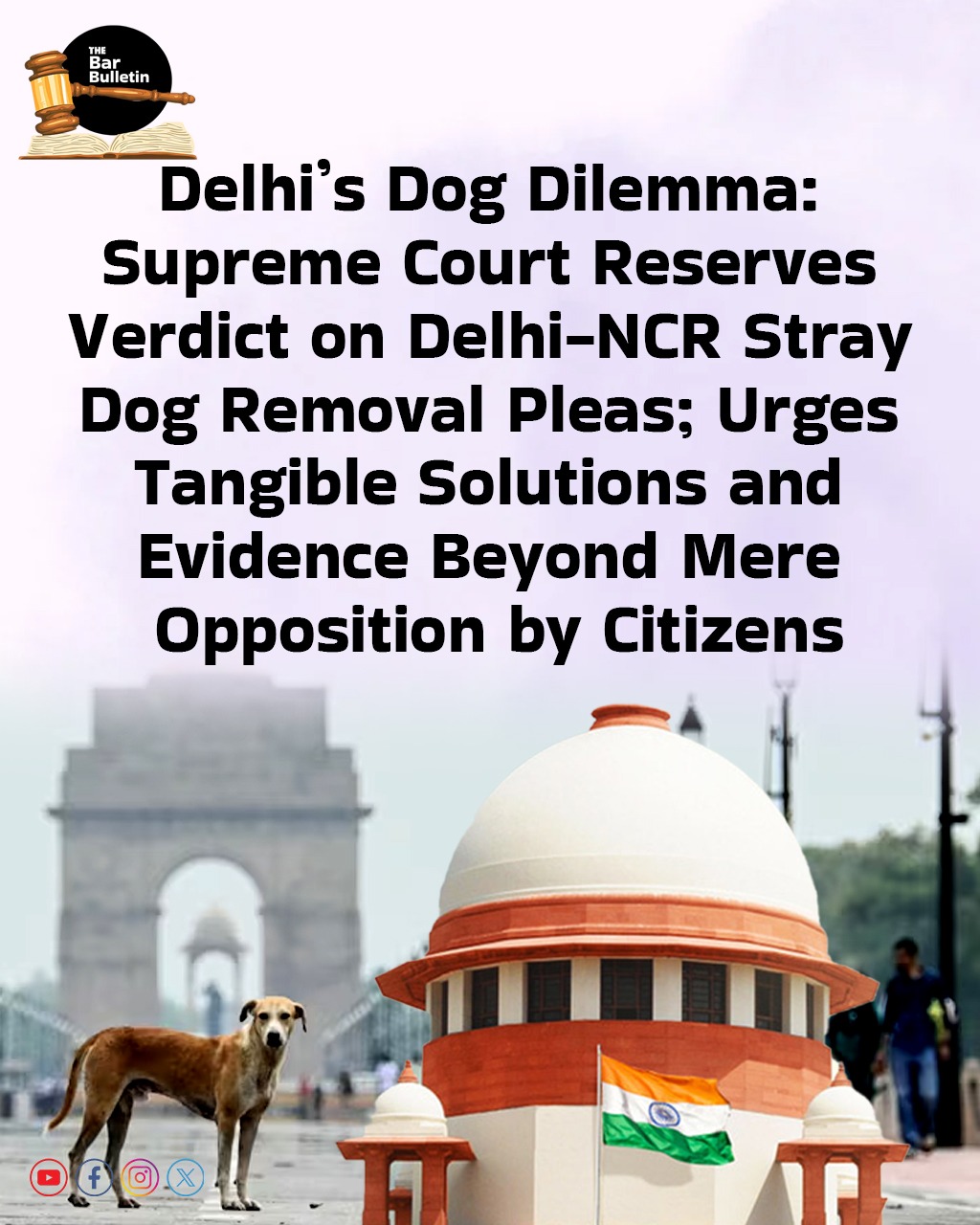In a landmark move, the Supreme Court of India has ordered civic bodies in Delhi-NCR to round up all stray dogs and permanently confine them to shelters within eight weeks. The order, passed on 28 July 2025, and reaffirmed on 11 August 2025, has sparked intense debate around public safety, animal welfare. The development has fractured public opinion and provoked sharp responses from activists, organizations, and policymakers.
- How It Started
The roots of the controversy can be traced back to a Times of India article titled “City Hounded By Strays, Kids Pay Price.” The report, cited by the Supreme Court in its very first order on July 28, 2025, laid bare a disturbing surge in dog bite incidents: over 25,000 cases reported in Delhi during 2024, and a staggering 3.7 million nationwide. The outcry underscored fears over public safety and the spread of rabies, especially among vulnerable groups like children and the elderly.
One such incident cited in court was the mauling of a six-year-old girl and a four-year-old boy, both suffering severe, life-altering wounds. The petition emphasized the anguish of urban residents forced to brave dangerous streets, and the failure of existing sterilization and immunization programs to stem either population growth or aggression among street dogs. This backdrop of crisis propelled India’s apex court into extraordinary action, initiating suo motu proceedings with a sharp focus on Article 21.
- A Closer Look at the 11 August Order
a) Judicial Observations
In its impassioned 18-page order, the two-judge bench of Justices J.B. Pardiwala and R. Mahadevan made observations on the situation, deeming it akin to an epidemic of dog attacks raging at the cost of innocent lives. The Court underscored repeated failures of municipal and animal welfare bodies over two decades, arguing that passive reliance on sterilization and release had proved futile. It recounted the particular exposure of children, elderly, and visually impaired individuals, whose daily movements through city streets had become perilous.
Importantly, the Court demarcated its concern for coexistence: “The idea behind co-existence is not the existence of one’s life at the cost of the other.” While urging compassion, the bench was unequivocal about the primacy of human rights: “There is absolutely no material to suggest that sterilization would eliminate the chance of the dog biting. Putting the dog back on the street…is a direct violation of our fundamental rights.”
b) Specific Directions
The Court mandated a series of urgent actions:
- Immediate removal: Authorities in Delhi, Gurugram, Faridabad, NOIDA, and Ghaziabad were directed to begin picking up all stray dogs, especially from “vulnerable localities and outskirts”.
- Creation of shelters: Civic agencies were ordered to construct shelter infrastructure for a minimum of 5,000 dogs within eight weeks, with round-up and construction efforts proceeding simultaneously.
- Permanent confinement: Captured dogs must never be released back onto the streets. Shelters must be equipped with feeding, medical care, and CCTV monitoring to deter cruelty or illegal releases.
- Maintenance of strict records: Daily logs of captured and sheltered dogs should be maintained and regularly reported to the Court.
- Contempt warning: Any obstruction by individuals or organizations would be met with strict contempt proceedings.
- Helpline: Authorities have been directed to set up helpline numbers to enable prompt action on dog bite reports, with offending dogs to be rounded up within four hours.
The Court was aware of the deep divide the order would create, warning against “virtue signalling” by animal lovers and calling for a united, pragmatic approach.
c) Legal Implications
The order explicitly set aside the Animal Birth Control (ABC) Rules of 2023, a legislation which mandated that sterilized and immunized street dogs be returned to their habitats. The Court, citing rapid growth in dog bite cases and making comparisons with other developed countries, declared such provisions as inadequate and incompatible with the public’s fundamental rights. The Court framed these measures as necessary to protect fundamental rights under Articles 19(1)(d) and 21, prioritizing safety and freedom of movement over animal entitlement.
- Public Response: Protests, Representations, and Outrage
The Supreme Court’s directives precipitated an immediate, widespread, and emotionally charged backlash. Animal rights activists and welfare groups organized street demonstrations across Delhi, with protestors, including rescuers and caregivers, being detained at iconic sites such as India Gate. Social media hashtags like #JusticeForCommunityDogs and #StrayDogLivesMatter trended nationwide.
Citizens are sharply divided along experiential and philosophical lines. Victims’ families, long-suffering residents, and public health campaigners hailed the order as an overdue protection, while “dog lovers” and neighbourhood feeders mourned the fate of thousands of animals facing abrupt and permanent removal.
Political figures also voiced their strong opposition. Priyanka Gandhi Vadra and Rahul Gandhi lambasted the court’s stance as inhumane and legally indefensible. Former minister Maneka Gandhi highlighted past international failures, citing the example of Paris, where mass culling or confinement failed to solve urban dog challenges.
The legal community and scholars also stressed on earlier Supreme Court and High Court judgments that had protected the rights of community dogs, enshrining their presence as intrinsic to urban India. Such events underscore not the intensity of popular attachment to street animals and the emotional volatility of the issue.
- Statements by PETA, FIAPO and Other Animal Protection Bodies
a) PETA India
PETA responded with a scathing assessment, branding the Supreme Court’s order “unscientific, ineffective, impractical, illogical, and illegal.” They contended that Delhi is home to around 1 million street dogs, and forced removal and “jailing” would cause uproar in communities that care deeply for them and chaos and suffering for the dogs on a large scale. They emphasized that data shows less than half the city’s street dogs have been sterilized or vaccinated.
“Displacement and jailing of dogs is not scientific and has NEVER worked,” stated Dr Mini Aravindan, cautioning that such measures do nothing to curb rabies or prevent bites. In essence, PETA called for robust, fully funded sterilization and immunization schemes, paired with public education to foster safe human-animal coexistence.
b) FIAPO (Federation of Indian Animal Protection Organisations)
FIAPO issued an official condemnation, warning that the Supreme Court order runs contrary to global public health guidance, India’s own laws, and humane, evidence-based practice. It stressed that relocation disrupts stable, vaccinated dog populations in which new, unvaccinated dogs quickly move in, eroding disease control.
They highlighted that the ABC Rules (aligned with WHO recommendations) require sterilized and vaccinated dogs to be returned to their home territories. Forced removal not only contravenes these laws but also diverts scarce resources away from mass vaccination and sterilization, risking outbreaks of stress, injury, and disease within overcrowded shelters.
FIAPO also pointed to successful in-situ management programs, like those in Jaipur and Goa, where dog population control and rabies reduction have been achieved without mass displacement. Other NGOs echoed similar sentiments, framing mass sheltering as logistically impossible and inhumane, even in the face of legitimate concerns over bites and rabies.
- The 14 August Order and Developments
On 14 August, a special three-judge bench of the Supreme Court comprising Justices Vikram Nath, Sandeep Mehta, and N.V. Anjaria heard multiple petitions challenging its earlier 11 August directive to remove all stray dogs from Delhi-NCR streets and confine them permanently to shelters. The order, originally passed by Justices J.B. Pardiwala and R. Mahadevan, had triggered sharp public criticism, widespread protests, and intervention applications from animal rights groups, NGOs, and senior lawyers.
The bench reserved its verdict on the stay applications but did not suspend the 11 August directive. As matters stand, civic agencies must continue the capture-and-sheltering process, even as legal and operational questions remain unresolved.
The Court was critical of longstanding administrative inaction. Justice Nath observed: “Parliament frames rules and laws, but they are not implemented. Local authorities are not doing what they should be doing. Everyone who has filed intervention will have to take responsibility.” The rebuke reflected frustration over gaps between statutory frameworks such as the 2023 Animal Birth Control (ABC) Rules, and their on-ground enforcement.
a) Key Arguments
Representing the Delhi government, Solicitor General Tushar Mehta framed the matter as a grave public health emergency, citing 37 lakh dog bites in 2024 and 305 rabies deaths, mostly of children. He argued that sterilisation alone does not prevent rabies and that separating stray dogs from human spaces was necessary to ensure safe movement of children and elders. While rejecting the case for culling, he endorsed permanent sheltering as the humane alternative, calling critics a “vocal minority” against the “silent majority” enduring daily risk.
Arguing from across the aisle, Senior advocates Kapil Sibal, Abhishek Manu Singhvi, and Sidharth Luthra contended that the order was logistically unsound and legally inconsistent. They pointed to the absence of shelter capacity, incomplete sterilisation drives, and evidence that sudden displacement could cause chaos and suffering. They stressed that Delhi had zero reported rabies deaths in recent parliamentary data, arguing that the order risked “creating a horror situation” rather than solving the problem. Petitioners urged the Court to prioritise scientific, phased solutions over blanket measures.
b) The Big Questions
The case has thrown up a clash between existing law (the ABC Rules), judicial urgency, and concerns regarding logistical feasibility. All intervenors have been ordered to file exhaustive affidavits and status reports. The bench signalled that its eventual ruling would rest heavily on concrete evidence and workable proposals. Until then, Delhi-NCR remains in a state of uneasy flux, caught between an urgent safety drive and the ethical-legal debate over the future of its street dogs.
- The Road Ahead
The Supreme Court’s intervention has cast a spotlight on deep civic, ethical, and legal fault lines. This ongoing litigation is set to reshape the contours of urban animal control in India. The Court’s stance reflects an “inflection point” in judicial engagement with competing constitutional priorities, a balancing act between security and movement, versus community compassion and ethical governance.
One can expect further hearings, public mobilization, and perhaps new models of engagement with stray populations to weigh hard public health metrics against softer, ethical imperatives. Until the interim order is pronounced, Delhi and its neighbouring cities remain suspended between urgency and uncertainty, the streets and shelters at the heart of a landmark national debate.


One thought on “Delhi’s Dog Dilemma: Supreme Court Reserves Verdict on Delhi-NCR Stray Dog Removal Pleas; Urges Tangible Solutions and Evidence Beyond Mere Opposition by Citizens”
Pingback: Has CJI Gavai Resuffled Justice Pardiwala’s Bench Combination Following Controversial Orders? - The Bar Bulletin